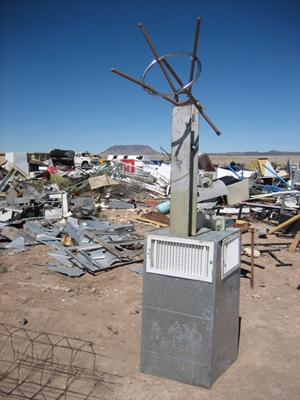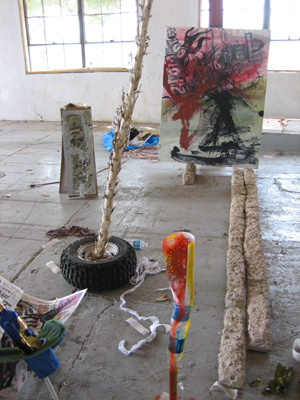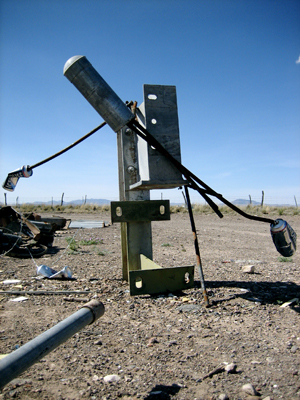In March, April and May, Brooklyn-based artist Bill Saylor lived and worked in Marfa as a Chinati artist in residence. Saylor took full advantage of the cavernous studio space in the former Marfa Ice Plant, filling the building with sculptures, paintings and drawings, and hosting movie screenings, parties and impromptu concerts. During his exhibition, it was difficult to tell what was art, what was left over from the last social gathering, or both. While in Marfa, Saylor mined the local junkyard for materials. For my conversation with the artist, I decided to do some trash talking.
No Country For Old Interns: How have you used junk in the past?
Bill Saylor: I remember finding a pile of old truck tire inner tubes that I cut and joined together with rubber glue into a long chain. I then re-inflated them—they hung from my studio ceiling down to the floor like some fucked-up DNA chain. The air would leak out after a few hours, and I’d fill them up again.
Another time I used a pile of stainless-steel meat hooks and a metal tripod stand that I found in an old meat-market studio I had. I put them together to make this overhead tree form, which ended up in a Kenny Schachter show called Unlearning back in the early ’90s.
And one of my favorites was a recycling cart I saw coming down the street. Some guy had packed a shopping cart full of beer cases about six feet tall with bags of plastic bottles all separated by color hanging off the side. It was such a great object in itself. I paid him $15 to stop for a moment to let me write a GPS number on it and then make a photo of it before he rolled off.
What attracted you to the idea of using junk from the Marfa junkyard?
I started to run out of painting materials, and out at the junkyard was this endless supply of things lying around. It just made it easier to keep working.
Is it easier to experiment in your work when you are using recycled or found materials?
I think it’s just different. When you start working with these found forms that had a previous use or history, you can make combinations that you may not think of otherwise. A lot of the sculptures were just balanced—done without cutting or welding—so there was a real sense of collage or drawing with the materials. I wasn’t slowed down by a lot of fabrication.
You created sculptures on site in the junkyard and then photographed them, right?
Yeah, I did. I made some video, too. I filmed with one hand while I was looking around and making things. Some parts of the video were straightforward; other parts were slowed down and abstracted. Adam from the Food Shark helped me edit it down to about 10 minutes. Thanks again, Adam!
The pieces were initially meant to be left in the junkyard and just photographed. I wasn’t really interested in shipping things back or storing things, but I did start bringing the pieces back into the Ice Plant studio, which was huge—like, 6,000 square feet or so. As they added up, I could start to see how they played off each other. Eventually I had a welder installed and used it for a few pieces. Thanks again, Michael!
I did end up keeping four out of 12 or so, but only as much as I could drive back in my van. No shipping. It was a little hard to let go in the end.
What did Tim [the man who works at the junkyard] think about what you were up to?
He was funny. I let him know that I was staying at Chinati and was making sculpture, and he was like, “Hey, whatever.” He liked the idea but was still a little possessive of some things, like sheet metal. That stuff is like gold out there. I think he was trying to build a barn or something.
There were other people there dumping stuff who saw me working. Their reactions were usually to tell me a story of a friend of theirs who made things as well—painted saw blades or something folksy or crafty like that.
How did your experience in the junkyard effect your exhibition installation? It seemed like you were really cultivating a look similar to what you might find the morning after a huge party.
I didn’t want to clean it up too much and make it look like a formal installation or anything. I was there to have fun, play and experiment. Leaving all the bottles from the parties we had was a nice reminder of my time there outside of making things.






